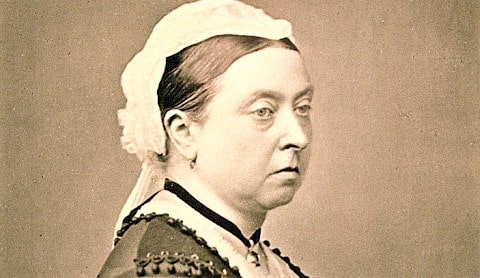
Queen Victoria is also known as Victoria I was born on May 24, 1819, at Kensington Palace, London. Victoria was Queen of the United Kingdom of Great Britain and Ireland from 1837 to 1901 and Empress of India (1876-1901). She was the daughter of Prince Edward, Duke of Kent and Strathearn, and Princess Victoria of Saxe-Coburg-Saalfeld.
With the accession of Victoria on June 20, 1837, ended because of the Kingdom of Hanover in force Salic Law, the women from the throne excluded, that has existed since 1714 personal union between Britain and Hanover.
During the following 63 years of Victoria’s reign, the British Empire reached the peak of its political and economic power, the upper and middle classes experienced an unprecedented economic heyday (Victorian era).
The influence of her husband Albert von Sachsen-Coburg and Gotha was decisive for their reign as well as her almost complete withdrawal from the public after his death in 1861. Overall, Victoria interpreted her role as a constitutional monarch very willfully and quite confidently.
With a total reign of 63 years, seven months and two days, Queen Victoria was the longest-reigning British monarch before being surpassed by Elizabeth II on September 9, 2015.
Because of her numerous descendants, she received the nickname “Grandmother of Europe”; for example, she is both the great-great-grandmother of the current Queen Elizabeth II and her husband Prince Consort Philip, Duke of Edinburgh.
The death of Victoria ended the rule of the House of Hanover, which passed to the House of Saxe-Coburg and Gotha when her eldest son Edward VII took over the throne (renamed in 1917 to House Windsor).
Early Life of Queen Victoria
Victoria’s father was Prince Edward Augustus of Kent and Strathearn, the fourth son of King George III. Until 1817, Edward’s niece, Princess Charlotte Augusta of Wales was the only legitimate granddaughter of George III.
His death in 1817 brought about a succession crisis in the United Kingdom and the Duke of Kent and his single brothers were invited to marry and have children. In 1818 the Duke married Princess Victoria of Saxe-Coburg-Saalfeld, a German princess whose brother Leopold was the widower of Princess Charlotte Augusta.
They had one child, Victoria, born at 4 am 15 May 24, 1819, at Kensington Palace in London. The Duchess of Kent already had two children from her first marriage to Emich Carl, 2nd Prince of Leiningen (1763-1814): Charles, Prince of Leiningen (1804-1856), and Princess Feodora of Leiningen (1807-1872).
Later in her life, Queen Victoria maintained close contact with her half-sister. Princess Alexandrina Victoria was baptized in private by the Archbishop of Canterbury, Charles Manners-Sutton, on June 24, 1819, in the Cupola Room of Kensington Palace.
She has baptized Alexandrina after one of its sponsors, Emperor Alexander Ist and Victoria after her mother. Other names proposed by his parents, Georgina (or Georgiana), Charlotte and Augusta, were abandoned on the instructions of the duke’s older brother, the prince regent (future George IV).
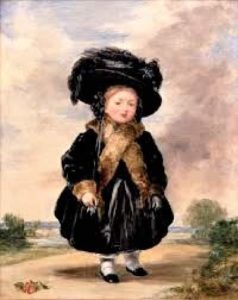
At birth, Victoria is in fifth place in the order of succession to the British throne behind her father and three older brothers: the Prince Regent, the Duke of York and the Duke of Clarence (future William IV).
The Prince Regent and the Duke of York are separated from their wives and are of advanced age so it is unlikely that they will have other children. The Dukes of Kent and Clarence married the same day a year before the birth of Victoria, but the two daughters of the Duke of Clarence (born 1819 and 1820 respectively) died in infancy.
Victoria’s grandfather and father died in 1820 less than a week apart and the Duke of York died in 1827. When his uncle George IV died in 1830, presumptive heiress of his last living uncle, William IV.
The Regency Act (in) 1830 load the Duchess of Kent to ensure the regency in case William IV died before Victoria had 18 years. The king did not trust in the duchess’ ability to play the role of regent and in 1836, he said in his presence that he wants to live up to the 18th Victoria birthday to avoid regency.
The Early Reign of Queen Victoria
On May 24, 1837, Victoria reached the age of 18, which meant that her reign was no longer necessary. Four weeks later, Victoria was awakened by her mother. Victoria should have understood that king IV.
At the age of 71, William died of heart failure on the 20th of June 1837 at 12 o’clock the previous morning. I was awakened by my mother at 6 o’clock in the Victoria diary, she told me that Canterbury archbishop and lord Conyngham are here and want to meet.
I got out of bed and went to the living room (I was only in my night), and I saw them. Conyngham then told me that my uncle was no longer, that he died at 2 o’clock this morning. And as a result, he wrote that I was the Queen.
Victoria was now the Queen of the United Kingdom.
Under the Salic Law in Hanover, no woman could be an heir to the throne. So the crown of Hanover was going to the Duke of Victoria’s uncle Cumberland and Teviotdale, and he became the king of Hanover, Ernest Augustus.
During her life, Victoria remained the duchess of Hanover princess, Brunswick, and Lunenburg. Because the young queen was not yet married and was childless. Ernest Augustus assumed heir to the United Kingdom until his first child was born in 1840.
When the queen rose to the crown, the government was controlled by the wing party. Except for a small chapter in 1830. Wing prime minister Lord Melbourne has become a powerful influence in the life of the queen who has no political experience.
But the Melbourne ministry would not remain strong for a long time. It was growing unpopularly, moreover, England faced considerable difficulties in colonies. In Canada, the UK faced the uprising (the 1837 uprising lasted until 1839). In Jamaica, the colonial legislature was protesting UK policy, with no legislation passed by parliament. In 1839, Lord Melbourne resigned.
Marriage to Prince Albert
On February 10, 1840, Queen Victoria married. It was a union foreseen for many years before and determined by the political interests of England. Prince Albert of Saxony-Coburg-Gotha, German and Victoria’s cousin, was one of the very few young men the sovereign adolescent had ever dealt with and certainly the first with whom he was allowed to converse alone.
When she became her husband, neither the predetermination nor the fear of change that the wedding entailed prevented a feeling of authentic veneration towards that man, not only handsome, exquisite and attentive, but also endowed with a fine political intelligence.
Alberto did not stop having his difficulties at first either. On the one hand, he was slow to get used to the position that the parliament, the prince consort, had drawn up for him beforehand, a status that acquired from him (in Great Britain and Europe) its specific dimensions.
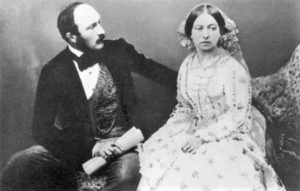
On the other hand, it took even longer for him to forgive certain maladjustment to the ways and manners of the English aristocracy, bypassing his innate shyness with the classic resource of official stubbornness and haughtiness of treatment.
But with the prince’s tact and perseverance, and the natural liveliness and common sense of Victoria, the royal couple cleared all obstacles in the same will and earned universal respect for their initiatives. His was a happy, placid, and homely love, from which four sons and five daughters were born; First World War.
The day came when Victoria was designated “the grandmother of Europe.”
Albert was a perfect husband for Queen Victoria and replaced Lord Melbourne in the role of adviser, protector, and factotum in the field of politics. And she carried out her mission with such success that the sovereign, still inexperienced and in need of that support, experienced no panic when in 1841 the once hated Peel finally replaced Melbourne at the helm of the cabinet.
From that moment on, Victoria discovered that Tory politicians were not only not terrible monsters, but because of their conservatism, they were much closer than the Whigs to their mood and beliefs.
Henceforth, both she and her husband showed a strong predilection for the conservatives, being frequent their controversies with the liberal cabinets headed by Lord Russell and Lord Palmerston.
Prince Albert’s political ability and the queen’s scrupulous respect for parliamentary mechanisms, on many occasions contrary to her own preferences, contributed greatly to restoring the prestige of the crown, seriously undermined since the last years of George III because of of the manifest incompetence of the sovereigns.
With the birth, in November 1841, of the Prince of Wales, who would succeed Victoria more than half a century later with the name of Edward VII, the succession question was resolved.
It can be said, therefore, that in 1851, when the Queen opened the first Great International Exposition in London, the glory and power of England were at their height. It is noteworthy that Alberto was the organizer of the event; there is no doubt that he had become the true shadow king.
The splendor of widowhood
Throughout the following years, Alberto continued to tirelessly deal with difficult government affairs and high issues of state. But her energy and health began to suffer from 1856, a year before the queen granted her the title of prince consort so that her rights as an English citizen were fully recognized for her husband since we must not forget its foreign origin.
It was in 1861 when Queen Victoria went through the most tragic period of her life: in March her mother died, the Duchess of Kent, and on December 14 her beloved husband expired, the man who had been her guide and supported her the weight of the crown.
As on other occasions, and despite the pain she was experiencing, the sovereign reacted with extraordinary fortitude and decided that the best way to pay tribute to the missing prince was to endorse the central objective that had encouraged her husband: to work tirelessly in the service of the country.
The small and thick figure of the queen was subsequently covered in a mourning garment and remained eternally faithful to the memory of Alberto, always evoking him in the most trivial daily conversations and episodes, while he had just consummated the indissoluble union of monarchy, people and state.
From that moment until his death, Victoria never ceased to show his iron will and his enormous ability to direct the destinies of England with apparent ease.
While in the political arena two new protagonists, the liberal William Gladstone and the conservative Benjamin Disraeli, began a new act in the history of English parliamentarian, the queen achieved from her privileged position a notorious international celebrity and an ascendant over her people of the that none of its predecessors had enjoyed.
In a supreme success, also it achieved a proverbially riotous aristocracy permeating out of the moral values of the bourgeoisie, as it had its heyday the Industrial Revolution and cut off the powers of the last nobility redoubt, the House of Lords.
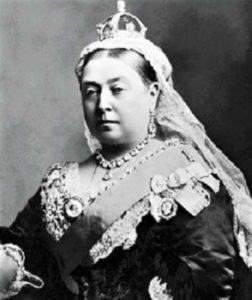
She herself took the most rigid guidelines of that morality and imprinted that personal stamp somewhat peaceful and narrow-minded, which has not been called Victorian.
The only parenthesis in this state of permanent widowhood was brought by the governments of Disraeli, the politician who best knew how to penetrate the queen’s character, cheer and flatter her, and definitively deviate her from her old predilection for the Whigs.
He also made it a symbol of imperial unity when he was crowned empress of India in 1877, after dominating the great national and religious sepoy’s rebellion there. Disraeli’s skillful policy also put the finishing touch to the formidable colonial expansion (the English empire came to comprise up to 24% of all land emerged and 450 million inhabitants, ruled by the 37 million of the metropolis) with the acquisition and control from the Suez Canal.
London thus became, for a long time, the world’s leading financial and exchange center. Endless colonial wars carried the British presence to the very ends of Asia, Africa, and Oceania. During the last three decades of his reign, Victoria became a living myth and the obligatory reference for all political activity on the world scene.
His small and robust image, nevertheless endowed with extraordinary majesty, was revered inside and outside Britain. His overwhelming common sense, the calm assurance with which he accompanied all his decisions, and his intimate identification with the desires and concerns of the middle class managed to cast the protective shadow of the so-called Widow of Windsor over an entire era and impregnate with Victorianism the second. middle of the century.
Queen Victoria Became Empress of India
After the guinea pig revolt of 1857 in India, the English East India Company, which ruled much of India, was dissolved and the British possessions and protectorates of the Indian subcontinent were formally incorporated into the British Empire.
The Queen had a fairly divided opinion on the uprising and condemned the atrocities perpetrated by the two camps. She writes of her feelings of horror and regrets following this bloody civil war 139 and she insists, pressed by Albert, for an official proclamation announcing the transfer of power from the company to the state had feelings of generosity, kindness, and religious tolerance.
At his request, a passage threatening to undermine local customs and religions is replaced by a paragraph guaranteeing religious freedom.
After the general election of 1874, Disraeli again became Prime Minister. It presents the Public Worship Regulation Act in 1874 which removed the rituals Catholic Anglican liturgy and Victoria strongly supported.
She preferred simple, short religious services and considered herself personally closer to the Presbyterian Church of Scotland rather than the Church of England’s Episcopalian. Disraeli also pushes the Royal Titles Act 1876 in Parliament for Victoria took the title of “Empress of India” from the 1 st May 1876. This new title was proclaimed by the darbar of Delhi on 1 st January 1877.
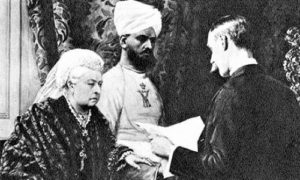
On December 14, 1878, the anniversary of the death of Albert, Victoria’s second daughter Alice, who had married Louis IV, died of diphtheria in Darmstadt. Victoria noted that the coincidence of dates was almost unbelievable and most mysterious.
In May 1879, it becomes great-grandmother on the occasion of the birth of Princess Feodora of Saxe-Meiningen and celebrates its poor and sad 60th anniversary. She felt “aged” by the loss of [her] darling child.
Between April 1877 and February 1878, Victoria threatened five times to abdicate to pressure Disraeli to act against Russia during the Russo-Turkish War, but her threats had no effect on the events or their conclusion with the Berlin Treaty.
Disraeli’s expansionary foreign policy, supported by Victoria, led to conflicts like the Anglo-Zulu War and the Second Anglo-Afghan War. She writes if we want to maintain our position of power forefront, we must … be prepared for attacks and wars, somewhere or elsewhere, continually.
Victoria saw the expansion of the British Empire as a civilizing and benign way of protecting the indigenous peoples against more aggressive powers, or cruel rulers, it is not our practice to annex countries unless we ‘Let us be forced and forced to do so.
To Victoria’s dismay, Disraeli lost the general elections of 1880, and Gladstone became Prime Minister again. When Disraeli died the following year, she was blinded by rapidly flowing tears.
End of Reign and Death
Following a custom that she maintains throughout her widowhood, Queen Victoria spends Christmas Eve 1900 at Osborne House on the Isle of Wight. She limps due to rheumatism and her vision was obscured by cataracts.
During the month of January, she felt weak and suffering 188 and in the middle of the month, she was drowsy … dazed and lost. After a long reign of over 63 years, she died January 22, 1901, at the age of 81, in his residence of Osborne.
His son and successor, Edward VII, and his oldest grandson, William II, were at her bedside. Her last wish was for her favorite Pomeranian, Turri, to be laid on her deathbed.
In 1897, Queen Victoria asked that her funeral be military because of her status as chief of the army and daughter of a soldier 95 and that white dominates over black. On January 25, Edward VII, the King of the United Kingdom and Prince Arthur of Connaught help carry her in her coffin.
She is dressed in a white dress and a wedding veil. Souvenirs recalling his extended family, friends, and servants are placed in the coffin at his request. One of Albert’s bathrobes is placed next to him with a plaster cast of her hand while a lock of John Brown’s hair and a photograph of him is placed in her left hand and hidden from the family by a well-positioned bouquet of flowers.
Her funeral was held Saturday, February 2 in St. George chapel of Windsor Castle and after two days of public display, she was buried alongside Albert in the royal mausoleum of Frogmore in Windsor Great Park.
[…] first, he lived tutoring at home through a housekeeper, Helen Bricka. Following the death of Queen Victoria in 1901, her parents had to travel to the British Empire for at least nine months in order to […]
[…] Queen Victoria died in 1901, George’s father became king under the name of Edward VII and George was made […]
[…] near Cobourg, and died on December 13, 1861, at Windsor Castle), was a German Prince who married Queen Victoria of the United Kingdom of Great Britain and […]
[…] Known for: wife of Edward, Prince of Wales, son of Henry VI; Wife of Richard von Gloucester; when Richard became King Richard III, Anne became Queen of England […]